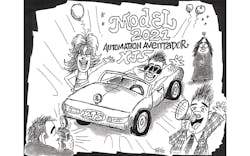Reality check: What is most important for the best automation project?
This Control Talk column appeared in the February 2021 print edition of Control. To read more Control Talk columns click here or read the Control Talk blog here.
Greg: To help sidestep the many distractions we all face, Hunter Vegas, engineering manager at Wunderlich-Malec, is going to help us realize what is truly most important for the best automation project today. Hunter is coeditor of the Process/Industrial Instruments and Controls Handbook, Sixth Edition. Hunter is also cofounder of the ISA Mentor Program and coauthor of 101 Tips for a Successful Automation Career.
Hunter, why all the chatter as seen in publications on getting more data, whether it is Industry 4.0, data analytics, the Industrial Internet of Things (IIoT) or digital transformation?
Hunter: Oh boy! I can see myself getting in trouble for this....
At this point in my career, the list of “Revolutionary Technical Trends” I have weathered is long indeed. In virtually every case, countless articles tout the unimaginable (yet rarely defined) cost savings available and predict a transformational sea change in future behavior. A few years later there is a new technical kid in town, the previous trend fades away, and it all starts again.
That is not to say that any of these technologies lack value. They often have real application in certain circumstances and can be quite useful when correctly applied. However, they are rarely the panacea promised by the marketing hype, and the expansive profitability improvements often fall short of expectation. (Let the nasty letters from the Industry IIoT Transformational Analytics Committee President begin!)
Greg: What about machine learning? Is it able to overcome the deficiencies experienced over decades of work with neural networks—particularly when it comes to dealing with interactions, tuning, load disturbances, measurement and valve precision, and dynamics of continuous processes? Who and how are practitioners going to verify the validity of analysis results?
Even if the correlations in the data analysis truly represent causes and effects as seen in first-principle models, decisions that are not automated are not repeatable or timely as seen in the motivation for procedural automation and state-based control. Process manufacturing is not like parts manufacturing, where servo mechanism control is used.
Processes have large and variable dead times, unmeasured disturbances, time variant and operating point changes in dynamics, fouling (e.g., heat transfer surfaces), deactivation (e.g., catalysts), and phase changes, and the process instrumentation response is far from ideal due to process exposure and many inherent and installation-imposed limitations. Often missing is the consideration of resonance and limit cycles and the effect of controller tuning and the transfer of variability from controlled variables to manipulated variables. The technologies touted seriously lack the considerable examples and details needed on how they are actually implemented in plants. The diversity of applications and the associated challenges and objectives in the process industry require process automation good experience and implementation.
Hunter: All of those are real issues. Machine learning and artificial intelligence are extraordinarily difficult to apply in practice. How does a computer know the difference between a real process change and a noisy spike in the data? Can a machine recognize sensor drift, or know when a transmitter is being calibrated, or understand that all of the valves just lost their air supply? In theory everything can be “programmed into the system” but consider the effort required to do that. More importantly, consider the resources required to maintain it. Is the potential profit worth the almost overwhelming cost to engineer it and keep it running?
Expert systems were all the rage for a while, until the reality and cost of the installation and upkeep became apparent. Neural networks and fuzzy logic controllers were going to take over the world, until they didn’t. Each of those technologies do have a place and can add value—in a select set of circumstances. But no technology is universally applicable.
Greg: What can we do to return the focus on what really matters?
Hunter: The amusing thing is that plants are full of real opportunity that is easy to achieve and the solutions have a lengthy track record of success. Automation of startup, shutdown and grade-change sequences can generate significant profit improvements. Look for touchy, manually-controlled batch reactions, areas with high reject rates, capacity bottlenecks, or systems requiring constant upkeep and maintenance. Any of these are prime targets for automation improvement.
If data is still your focus, start by considering the data source. Information is only useful if it is accurate and gets to the right person at the right time. Otherwise, it just adds to the noise that is already overwhelming operations. Further, any analytics based on that information could lead to worthless and possibly wrong conclusions. Are your instrument readings accurate? Is lab data getting quickly fed into the control system? Can analytical data be inferred from existing measurements to give a real-time process control value? Are your graphics telling the operator what they need to know? Those are real value propositions.
Greg: What are some reality checks to help avoid distractions?
Hunter: Start by seriously questioning vague, undefined promises when presented with any new technology. Ask for documented proof of the success and profit improvements. Get past the salesman who sold it and the manager who championed it, and talk to plant personnel who have implemented it and live with it. Do they think it was a worthwhile endeavor? Did the profits materialize? What would they do different?
Greg: What is important for getting the best automation project scope?
Hunter: The most common reason for project failure is poor scope definition, so focus your energies there. Time spent investigating a project, defining the true sources of improvement, setting realistic goals and working through the logistics will reap huge rewards and dramatically reduce risk. Unfortunately, many toss a vague scope out for bid and let the contractors sort it out. This rarely ends well.
Greg: What can we do to get the best instrumentation design and installation?
Hunter: Focus on fundamentals. Learn and understand the measurement methods rather than relying on a salesman who may be incented to sell the most expensive option. Get past the marketing brochures and read up on the underlying technology. Consult vendor-neutral sources of information or talk with seasoned automation practitioners.
Greg: What can we do to make better automation as exciting as new ways of getting more data or ambiguous methods of getting better performance?
Hunter: Well, I think we start by giving it a provocative, compelling title and then write loads of articles on it, extolling the virtues and endless profit improvements. Perhaps we could start the next trend!
Greg: How can we get more practitioners involved in sharing their knowledge and motivation?
Hunter: That is a tough one. Some of the most of the knowledgeable people eschew social media. So, while inexperienced automation professionals are doing internet searches and scanning chat rooms, the few experienced individuals who are sharing knowledge like those on the new ISA 5.9 committee to generate a PID technical report are writing books, articles, and giving talks because that is what they know. However, with rare exception, most practitioners welcome the opportunity to explain something if directly asked. If you are lucky enough to have one down the hall, walk down and solicit their opinion. Otherwise, scan for articles and drop the authors an email.
Greg: The ISA Guide to the Automation Body of Knowledge, Third Edition provides a basic understanding of almost every aspect of an automation system design. The ISA 101 Tips for a Successful Automation Career, inspired by the Mentor Program, provides concise career and technical guidance. The Process/Industrial Instruments and Controls Handbook, Sixth Edition provides essential knowledge and best practices for achieving the best automation system performance.
The amount of material here can be overwhelming. I suggest you start with reviewing the best practices at the end of each subsection particularly in the chapters on process variable measurements, control valves and variable frequency drives, control communications and improving process performance in the McGraw-Hill Handbook coedited by the two of us. These best practices provide focused important practical detailed guidance from 50 experts in the process industry. You can then decide how much of each subsection you want to read to gain a better understanding.
In the meantime, the cartoon shows how to start automation as a new splashy trend.
10.Tie Die shirts
9.Bedazzled anything
8.Popped collars (and/or wide collars)
7.Parachute Pants
6.Overalls with one strap down
5.Leisure jump suits for men
4.Leg warmers
3.Crocs and Socks
2.Rat tails and/or mullets
1.Sagging pants
About the Author
Greg McMillan
Columnist
Greg K. McMillan captures the wisdom of talented leaders in process control and adds his perspective based on more than 50 years of experience, cartoons by Ted Williams and Top 10 lists.

Leaders relevant to this article:



